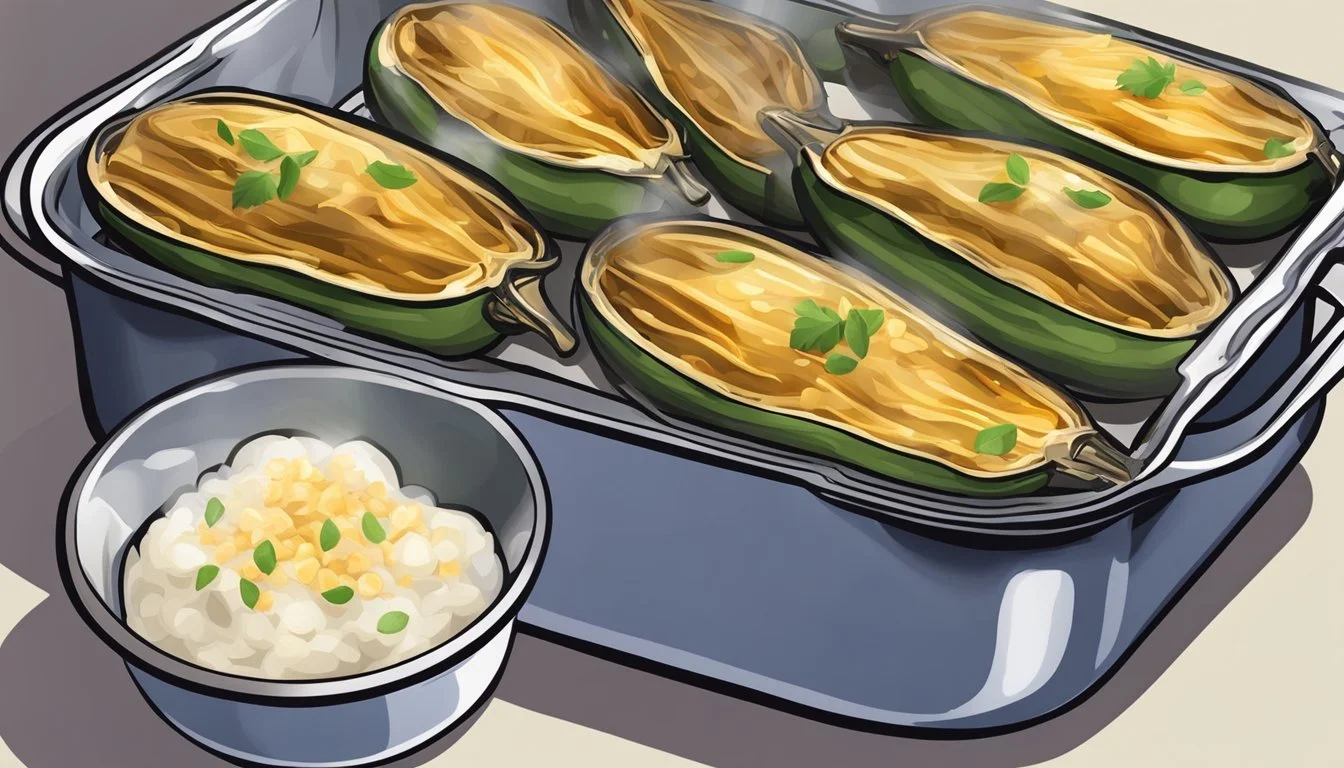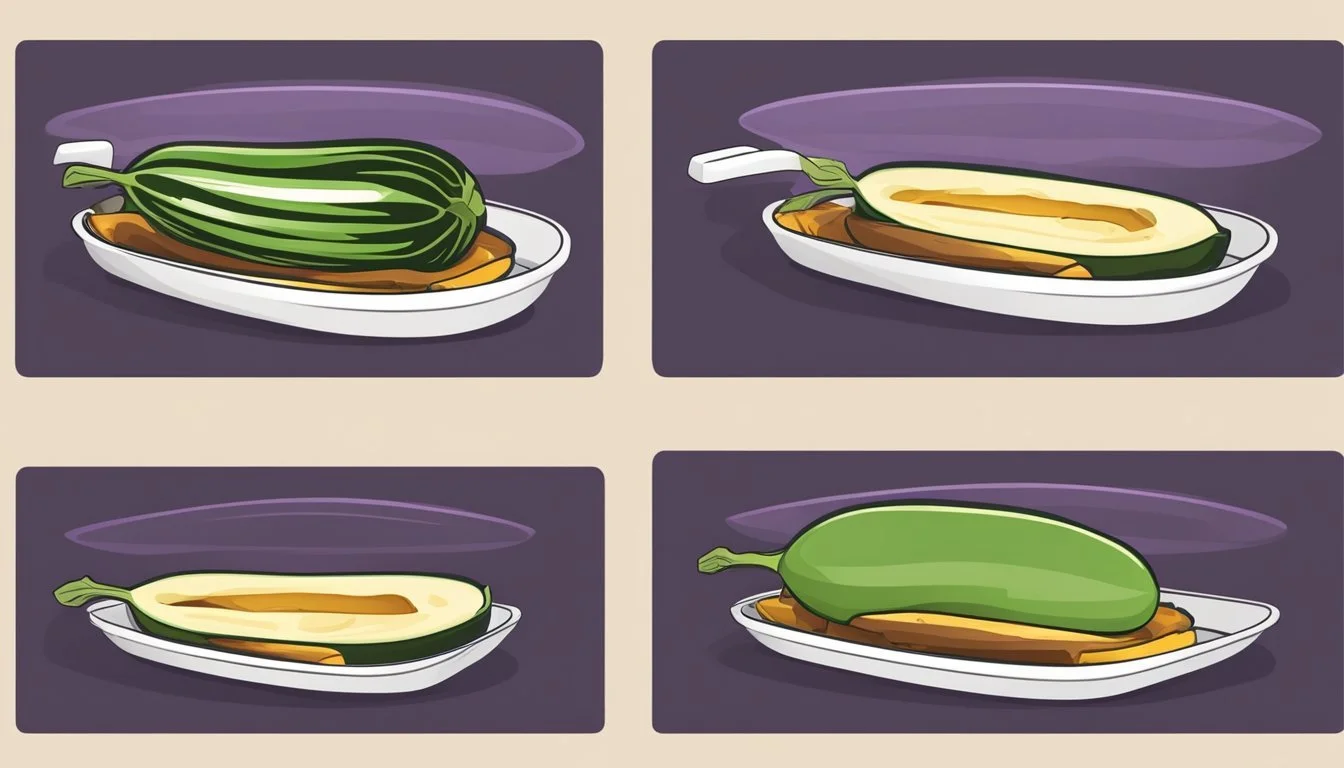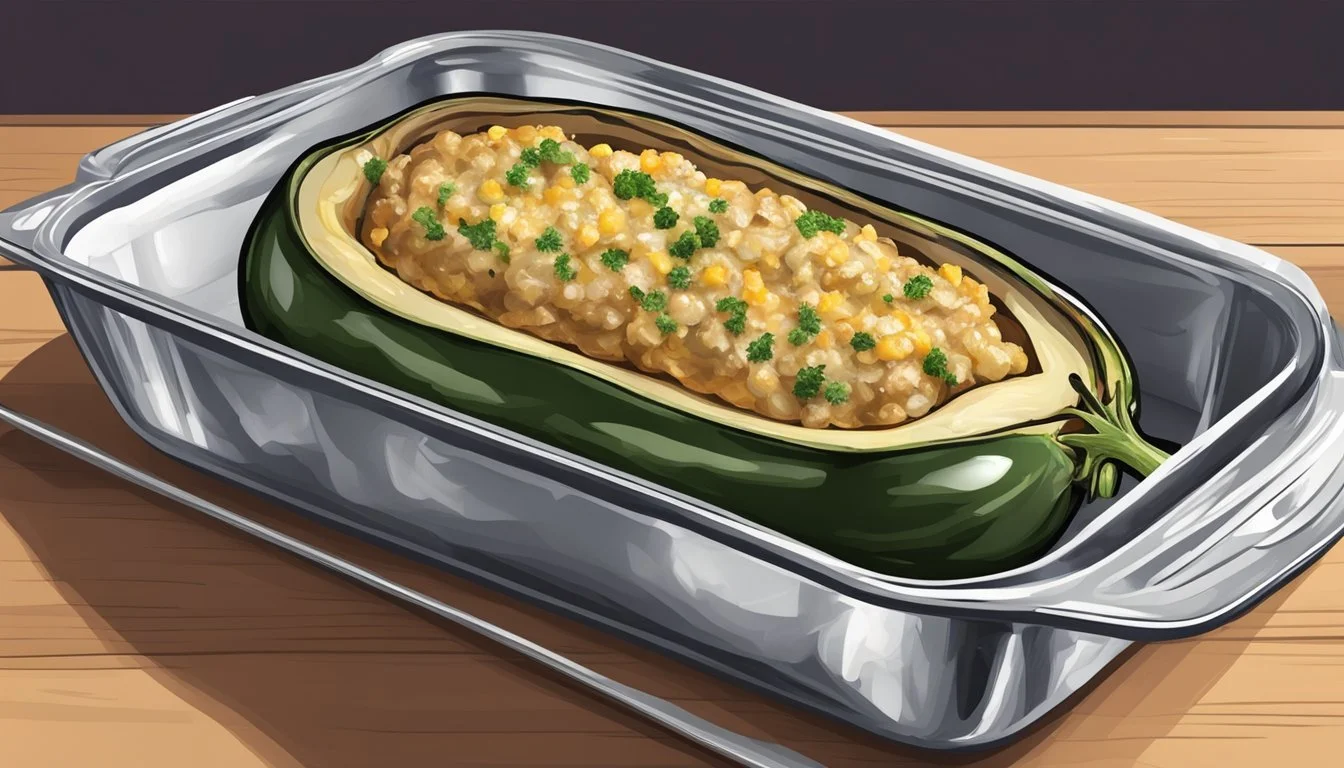Best Way to Reheat Stuffed Eggplant
Tips for Preserving Its Tenderness and Flavor
Stuffed eggplant is a delightful dish with its tender flesh and savory filling, which creates a culinary experience that's as delicious on the second day as it was when first prepared. However, reheating this dish without compromising its texture and flavor can be a challenge. Ensuring that the eggplant remains succulent and the filling stays flavorful requires a reheating method that takes into account the unique properties of the ingredients.
Reheating stuffed eggplant in the oven is often the best method to achieve a dish that's evenly warmed with a filling that's just as satisfying as when it was freshly cooked. The oven's dry heat helps to maintain the structure of the eggplant while preventing it from becoming too soggy. Oven temperatures, typically recommended at around 350°F, gently warm the stuffed eggplant, making sure that it heats through without drying out the flesh or scorching the filling.
In contrast, microwaving, although quicker, may result in a less than optimal texture, with the eggplant potentially turning rubbery and the filling losing some of its robustness. Therefore, it's advisable to opt for the oven-reheating method to preserve the enjoyment of the eggplant's tender texture and filling's depth of flavor. This approach can help maintain the integrity of stuffed eggplant, allowing it to be a dish that's relished even beyond its initial serving.
Overview of Stuffed Eggplant
Stuffed Eggplant is a versatile dish that marries the tender flesh of the eggplant with a variety of savory fillings. It serves as a delightful main course or a rich side dish and offers a multitude of nutritional benefits.
Characteristics of Eggplants
Eggplants, at the heart of this dish, are known for their distinct purplish skin and spongy, absorbent flesh. When selecting eggplants for stuffing, one should look for a smooth and shiny exterior, which indicates freshness. Upon cooking, eggplants become remarkably tender, providing a perfect vessel for a range of fillings.
Selecting Quality Ingredients
To ensure the best taste and texture in your stuffed eggplant, choose ingredients that complement the subtle flavors of the eggplant. Fresh vegetables, quality proteins (for both meat-based and vegetarian options), and robust herbs enhance the dish. For the vegan audience, plant-based fillers can substitute cheese or meat, aligning with dietary preferences without compromising on flavor.
Health Benefits and Nutritional Value
Eggplants are known for their nutritional content, being low in calories while offering beneficial fiber and potassium. These are essential components for maintaining good digestive health and regulating heart function. Stuffed eggplant can be aligned with vegetarian and vegan diets, making it an inclusive option that can be tailored to a variety of nutritional needs.
Nutritional Highlights of Eggplants:
Fiber: Aids in digestion
Potassium: Crucial for heart health
Low in Calories: Eggplant is a low-calorie vegetable, making it ideal for weight management when used in a balanced diet.
This dish not only delivers on flavor but also provides a substantial, health-conscious meal option.
Fundamentals of Preparing Stuffed Eggplant
Preparing stuffed eggplant requires attention to detail from perfecting the base recipe to ensuring the eggplant's tenderness and integrating seasoning for an enhanced flavor profile.
Core Stuffed Eggplant Recipe
The quintessential stuffed eggplant begins with choosing fresh, medium-sized eggplants. They should halve the eggplants lengthwise, carefully scooping the flesh to create a shell about a quarter-inch thick. The next step involves finely chopping the reserved flesh for the filling. Essential ingredients usually include a combination of grains, such as rice or quinoa, with flavorful elements like onions, garlic, and possibly ground meat, all bound together by a rich tomato sauce or cheese.
Ingredients:
Eggplants
Olive oil
Chopped onions
Garlic
Ground meat or alternative protein
Grains (rice, quinoa)
Tomato sauce or cheese
Preparation steps:
Halve the eggplants and scoop out the flesh.
Sauté onions and garlic in olive oil.
Add chopped eggplant flesh and cook until tender.
Combine with cooked grain and meat, season with salt and pepper.
Stuff the mixture into eggplant shells.
Bake until the filling is heated through and eggplant skin is tender.
Culinary Techniques for Tender Eggplant Flesh
To achieve tender eggplant flesh, they need to adequately roast or bake the eggplant after stuffing it. Preheating the oven to around 375°F (190°C) is ideal. Cooking the stuffed shells for 45-50 minutes will soften the flesh, meld the flavors, and ensure that the inside is completely warm. Using a fork, they can check the tenderness of the eggplant flesh, which should yield easily when properly cooked.
Essential Seasonings and Flavor Enhancements
Seasoning the filling correctly is vital for a savory end result. They should be generous with foundational seasonings such as salt and pepper, adjusting to taste. To enhance the flavor, incorporation of aromatic herbs like thyme, basil, or oregano, can elevate the dish. If including cheese, a blend of melty cheeses like mozzarella coupled with a sharper cheese like Parmesan can add depth. For a hint of brightness, a squeeze of lemon juice or a dash of vinegar can be added just before serving.
Seasoning suggestions:
Salt and pepper, to taste
Aromatic herbs (thyme, basil, oregano)
Cheese blend (mozzarella, Parmesan)
Lemon juice or vinegar for brightness
Customization of Stuffed Eggplant
The versatility of stuffed eggplant allows for customization to accommodate various dietary preferences and the inclusion of a mix of flavors through different fillings and garnishes.
Variations for Dietary Preferences
For those adhering to special dietary needs, stuffed eggplant can be tailored to fit vegan, vegetarian, and gluten-free diets. Cheeses like mozzarella can be replaced with plant-based alternatives for vegans. Gluten concerns are addressed by substituting breadcrumbs with gluten-free grains or omitting them altogether.
Vegan modifications:
Substitute dairy cheese with vegan cheese
Use plant-based proteins in place of meat
Gluten-Free modifications:
Replace breadcrumbs with gluten-free grains like quinoa or rice
Experimenting with Different Fillings
A stuffed eggplant's flavor profile can be significantly altered by the filling used. Traditional recipes might include ground meats, but one can explore other proteins like chicken, lamb, or plant-based substitutes. Adding a variety of vegetables such as diced tomatoes, bell peppers, or mushrooms can enhance the dish's nutritive value and taste.
Protein options:
Meat: Ground beef, lamb, chicken
Vegan protein: Lentils, chickpeas, tofu
Vegetable additions:
Tomatoes, bell peppers, spinach, mushrooms
Creative Toppings and Garnishes
To finalize the dish, creative toppings and garnishes can be added for additional texture and taste. Fresh herbs like parsley or basil can bring freshness, while a sprinkle of cheese provides a rich, melt-in-your-mouth experience. Considering tomatoes, a layer of tomato slices or a dollop of tomato sauce can complement the eggplant's natural flavors.
Herbs and cheese:
Fresh parsley, basil
A final layer of mozzarella or parmesan
Tomato additions:
Slices, sauce, or sun-dried tomatoes for a tangy twist
Proper Reheating Techniques
Reheating stuffed eggplant requires careful attention to retain its tender flesh and savory filling. The techniques vary depending on the desired outcome, whether it's preserving moisture or adding crispness.
Using the Oven for Ideal Warmth
An oven is typically the best option to reheat stuffed eggplant evenly, maintaining its quality. To reheat:
Preheat the oven to 350°F (175°C).
Place the stuffed eggplant in an oven-safe dish.
Cover with foil to retain moisture.
Heat for 15-25 minutes, or until the internal temperature reaches 165°F (74°C).
Tips:
For a crisper top, remove the foil in the last 5 minutes.
To avoid drying out, add a splash of water or vegetable stock to the dish before covering.
Skillet Method for Crispier Texture
Using a skillet can add crispness to the eggplant's exterior while warming the interior.
Heat a skillet over medium heat.
Add a small amount of oil or butter to the skillet.
Place the stuffed eggplant in the skillet.
Cover and cook for a few minutes, checking frequently.
Note: Rotate the eggplant occasionally to ensure even warming and to prevent burning.
Microwave Tips for Quick Reheating
The microwave offers a quick way to reheat leftovers, though it may not preserve the texture as well as other methods.
Transfer the stuffed eggplant to a microwave-safe container.
Cover with a microwave-safe lid, offsetting it to allow venting.
Reheat on medium power in 30-second bursts, checking for warmth.
Caution: Microwave in short intervals to avoid overcooking and to ensure that the filling heats thoroughly without the eggplant becoming rubbery.
Serving and Pairing Suggestions
When serving reheated stuffed eggplant, the goal is to complement its rich flavors and create a balanced meal. Proper pairings enhance the dining experience, turning a simple dish into a memorable feast.
Accompaniments for Stuffed Eggplant
To start, one should consider light and refreshing side dishes that will not overshadow the eggplant's savory profile. A crisp salad dressed in a zesty vinaigrette offers a refreshing counterbalance to the richness of stuffed eggplant. Alternatively, a side of pasta tossed in tomato sauce can bridge the flavors, especially if the stuffed eggplant features Mediterranean spices.
Salad Options:
Mixed greens with lemon vinaigrette
Arugula and shaved Parmesan
Pasta Choices:
Angel hair with light marinara
Penne with garlic and olive oil
Making a Complete Mediterranean Meal
For those seeking to craft a full Mediterranean meal around stuffed eggplant, incorporation of compatible flavors is key. Adding a side of fluffy couscous or herbed rice can absorb the dish’s flavors and provide a satisfying base, while a small portion of falafel or grilled lamb can add a delightful contrast and depth to the meal.
Grain Accompaniments:
Couscous with fresh herbs
Rice pilaf with pine nuts
Protein Additions:
Lamb kebabs with tzatziki sauce
Chickpea falafel with tahini drizzle
Beverage Pairings for Enhanced Experience
To elevate the meal further, a thoughtful beverage pairing is essential. A light, crisp white wine like a Sauvignon Blanc can cut through the richness, while for non-alcoholic options, a sparkling water with a wedge of lemon or a cooling mint iced tea can refresh the palate between bites.
Wine Selection:
Sauvignon Blanc: Bright acidity with herbal notes
Chardonnay: Lightly oaked for a smooth finish
Non-Alcoholic Choices:
Lemon-infused sparkling water
Chilled mint iced tea
Preservation and Storage
Proper preservation and storage techniques are essential in maintaining the quality of leftover stuffed eggplant. These methods will help ensure that the meal retains its tender flesh and flavorful filling when reheated.
Tips for Storing Leftover Stuffed Eggplant
When storing stuffed eggplant leftovers, one should let the dish cool to room temperature before refrigerating. To prevent moisture buildup, which can lead to sogginess, they should wrap the eggplant tightly in plastic wrap or aluminum foil.
Cooling: Allow to reach room temperature.
Wrapping: Use plastic wrap or aluminum foil.
If possible, leftovers should be stored in airtight containers to minimize the exposure to air. This storage practice can be crucial for maintaining the eggplant's texture and the filling's taste.
Airtight Containers: Store in a fridge set at or below 40°F (4°C).
Usage Period: Consume within 3-5 days for optimal taste and safety.
Maximizing Freshness and Shelf Life
To maximize the shelf life of stuffed eggplant:
Temperature: Refrigerate promptly in a fridge set to 40°F (4°C) or below.
Freezing: For longer storage, individual portions can be frozen. They should first freeze on a tray to keep their shape, then be transferred to freezer-safe bags or containers.
One should note:
Freezing Duration: Stuffed eggplant can be kept frozen for up to three months.
Reheating: Thaw in the refrigerator before reheating to ensure even warming.
By following these steps, the integrity of the eggplant and the flavor of the filling are preserved for a satisfying meal when reheated.






